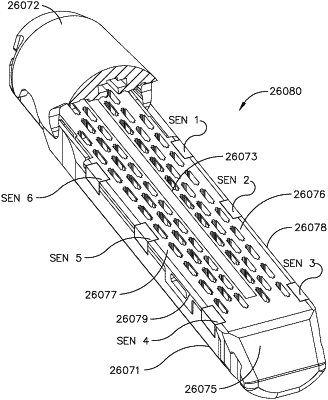| CPC A61B 17/07207 (2013.01) [A61B 5/14532 (2013.01); A61B 5/6886 (2013.01); A61B 18/1445 (2013.01); A61B 34/20 (2016.02); A61B 34/37 (2016.02); A61B 90/361 (2016.02); G16H 10/60 (2018.01); G16H 30/20 (2018.01); G16H 40/63 (2018.01); G16H 40/67 (2018.01); G16H 50/20 (2018.01); A61B 2017/00017 (2013.01); A61B 2017/00022 (2013.01); A61B 2017/00035 (2013.01); A61B 2017/00119 (2013.01); A61B 2017/00123 (2013.01); A61B 2017/00221 (2013.01); A61B 2017/00398 (2013.01); A61B 2017/00734 (2013.01); A61B 2017/07214 (2013.01); A61B 2017/07257 (2013.01); A61B 2017/07271 (2013.01); A61B 2017/2926 (2013.01); A61B 2017/320097 (2017.08); A61B 2018/00904 (2013.01); A61B 2018/1253 (2013.01); A61B 2018/126 (2013.01); A61B 2090/373 (2016.02); A61B 2217/005 (2013.01); A61B 2217/007 (2013.01); A61B 2218/008 (2013.01)] | 20 Claims |

|
1. A surgical instrument, comprising:
an end effector, comprising:
a first jaw;
a second jaw movable relative to the first jaw to grasp tissue therebetween;
an anvil;
a staple cartridge comprising staples deployable into the tissue, wherein the staples are deformable by the anvil;
a first sensor located on a first lateral side of the staple cartridge and configured to provide a first sensor signal according to a physiological parameter of the tissue indicative of proximity of the first sensor to cancerous tissue;
a second sensor located on a second lateral side of the staple cartridge opposite the first side and configured to provide a second sensor signal according to the physiological parameter of the tissue indicative of proximity of the second sensor to cancerous tissue;
a control circuit coupled to the sensor, wherein the control circuit is configured to:
receive the first and second sensor signals; and
detect a presence of a cancerous tissue based on a magnitude of the first sensor signal or the second sensor signal;
determine, in response to a detection of the presence of the cancerous tissue, a direction in which the end effector should be moved to increase a distance of the end effector from the cancerous tissue;
generate an indication of the direction in which the end effector should be moved to increase the distance of the end effector from the cancerous tissue.
|